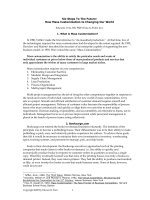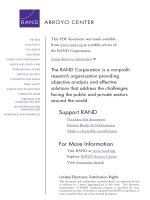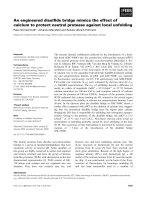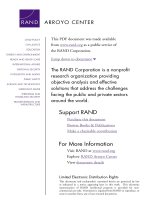Dairy Farms for the Future: Diversifying farms to expand direct markets for milk products docx
Bạn đang xem bản rút gọn của tài liệu. Xem và tải ngay bản đầy đủ của tài liệu tại đây (286.3 KB, 54 trang )
Dairy Farms for the Future:
Diversifying farms to expand
direct markets for milk products
Authors:
Kerri Sands
Maine Farms Project of Coastal Enterprises, Inc.
Unity, Maine
and
Russell Libby
Maine Organic Farmers and Gardeners Association
Unity, Maine
December, 2004
2
Inspiration and Process
In early 2003, at the height of a statewide discussion about the future of Maine’s
dairy industry, the Maine Department of Agriculture, Food, and Rural Resources
was awarded a grant from the USDA’s Federal State Market Improvement
Program (FSMIP) to conduct a project entitled, “Dairy Farms for the Future:
diversifying farms to expand direct markets for milk products in three regions of
Maine.” This project brought Federal, State and private efforts together to help
diversify and strengthen Maine’s dairy industry by:
• Identifying new regional direct-to-consumer, wholesale and institutional
markets for Maine milk and value-added milk products.
• Transitioning and diversifying several dairy operations to better serve
regional markets.
• Developing regional strategies for milk distribution system and farmland
protection.
The Project’s goal was to improve the marketing opportunities for small and
medium sized dairy farms in Maine in order to maintain the profitability of those
farms and keep agricultural lands productive.
This report, prepared by Kerri Sands of the Maine Farms Project of Coastal
Enterprises, Inc., and Russell Libby of the Maine Organic Farmers and
Gardeners Association, is a part of the research done for the Dairy Farms for the
Future project.
The authors thank the Department for getting this project underway, and the
many chefs, retailers, distributors, and farmers who helped provide information
through interviews, a focus group meeting and a survey.
Contact us:
Kerri Sands, , 207.772.5356 x 114
Russell Libby, , 207.568.4142
3
Table of Contents
About this report
4
How this report will help you
4
How to find what you need in this report
4
Section 1: New Dairy Opportunities for Maine: A Brief Overview
5
Section 2: Key Market Issues for You to Consider
8
Section 3: How Big is a Local Market?
10
Section 4: Pricing and Regulatory Issues
14
Conclusion
15
Resources: Organizations and People
17
Resources: Publications
20
Resources: Articles
22
Appendix A: About the Survey of Purveyors of Maine Specialty Dairy
23
Appendix B: Blank Survey
24
Appendix C: Survey Results, Tabulated
27
Appendix D: Survey Results, General Comments (by topic)
40
Appendix E: Conversation with a Major New England Distributor
47
Appendix F: Maine Cheese & Value Added Dairy Focus Group
50
4
About this report
This report is intended primarily as a guide for Maine farmers who are
considering starting a value-added dairy enterprise. We will describe some value-
added possibilities for dairy farmers, and how to assess whether these options
might fit your farm. We started the process with a review of some options
already being considered or implemented on Maine dairy farms, and conducted a
focus group that included chefs, a cheese importer, a cheese retailer, and a food
writer. From there, we developed a survey used in interviews with a number of
specialty dairy purveyors (retailers, chef, distributors) around Maine, and a
specialty distributor in the Boston area. We also pulled together production &
market information from our collective experience with Maine producers,
marketers, and dairy advisors. Conversations with farmers and with people
interested in either producing or buying specialty dairy products were at the heart
of this work.
How this report will help you if you’re considering value-added
dairy
We hope that this report will help you answer this set of key market questions:
1. Do you have a clear picture of your market situation?
2. Do you have a market that can absorb the milk from your current or
projected herd size?
3. Does your herd size need to be bigger or smaller?
4. Where might additional customers be found?
How to find what you need in this report
• You’ll find a recent history of Maine value-added dairy in Section 1.
• We’ll highlight for you the critical marketing issues that we learned from
our survey in Section 2.
• We’ll help you figure out your market situation and match it with your
farm type and production level in Section 3.
• For pricing and regulation information, see Section 4.
• You can find a comprehensive list of resources (people, publications) in
the Resources section.
• If you want to read about the survey we did and the highlights of the
interviews, you’ll find that in Appendices A-F.
5
Section 1
New Dairy Opportunities for Maine: A Brief Overview
Twenty years ago, if you said you were going to be a dairy farmer, everyone
knew what you meant. You were going to buy some cows, milk them, and sell
the milk to a processor. Now, in 2004, there are more options, options about
scale, about markets, even about which kind of animal to milk.
The dairy industry used to be very homogenous: almost everyone milked cows,
herd sizes ranged up to 200 cows, and rarely beyond, and most on-farm
processing took place in communities with limited delivery options. A few people
were making butter; a few had started making cheese during the 1970’s, mostly
using goats.
Now Maine has about 375 dairy farmers who ship milk to processors, down from
949 in 1987. But, from a relative handful in 1987, there are now over a dozen
cheesemakers, about a dozen farms processing fluid milk, and at least that many
producing butter. Forty-eight different businesses are listed as processors.
Sixty of the 375, and a few more of the specialty dairies, produce certified
organic milk. These farms make everything from cultured butter to aged sheep’s
milk cheese, unhomogenized milk in glass bottles to ice cream. As national
markets have consolidated, farmers have been trying to carve out marketing
identities that give them some long-term security.
Some critical elements of the dairy industry have changed in recent years.
Those changes influence farmers’ choices about what is possible, both on the
production and on the marketing side.
Production and Scale
Milk production has remained relatively steady. Maine total cow population is
about 36,000 cows and Maine’s dairy farmers continue to produce just over 50
million pounds of milk a month, down slightly from the peak production of a
decade ago. Pressure to keep production costs low has led many farmers to try
to spread those costs over more cows. That pressure is high in every part of the
country, and will continue to influence production choices into the future.
For example, in 1987, the average farm milked about 60 cows, with the largest
farms milking several hundred cows. Today much of Maine’s milk is being
produced on fewer, larger farms and the average farm milks 100 cows, with a
few farms milking closer to a 1,000 cows. Even with this trend, Maine’s farms
continue to be smaller than those in other parts of the country. California’s dairy
farms for example, often have 5,000 cows per farm with one large operation
housing 90,000 cows in 10 related buildings.
6
In the same time period, the cost of entry into commercial dairy production has
dramatically increased. Every element of production costs, from building a dairy
herd, to storing feed and purchasing or maintaining equipment, to paying
property taxes, has escalated. Meanwhile, the price of milk remains low, often
at levels similar to those in 1986.
Markets
Across the country, markets for milk have been consolidating over the past two
decades. While milk was largely a regional product in the 1980’s, now there are
several companies (Dean Foods and Dairy Farmers of America’s National Dairy
Holdings) that control significant parts of the national market. These companies
have processing capacity in many areas in the country, and often market under
the brand of companies they have purchased. In Maine, the Grant’s label is now
owned by Garelick, which is in turn owned by Dean Foods. The other milk
processing plants in Maine are Hood’s, Houlton Farms and Oakhurst Dairy, with
the latter two locally owned.
A relatively new regional market for organic milk developed in the mid-1990s,
with several regional processors slowly developing their products as national
brands. Two major competitors have emerged; Horizon, which is now a
subsidiary of Dean Foods; and the CROPP Cooperative, which is processing
under the Organic Valley label. Both purchase liquid milk from a significant
number of Maine farmers. Horizon processes organic milk in Bangor at the
Garelick plant. Another recent entry into the Northeast market is Hood,
marketing under the Stonyfield Farms label in partnership with that company,
which primarily makes yogurt.
The other important element in marketing, beyond the direct competition from
both large and small processors already in the marketplace, is the increasing
consolidation of the supermarket sector. Where Augusta, Maine, in 1978 had 11
different markets under 10 different owners, now there are six markets under 4
owners. The high degree of competition between these few large supermarket
chains (in Maine, primarily Hannaford’s, Shaw’s, and Wal-Mart) has reduced and
limited small producers access to these markets. Often there is a requirement
that the producer/processor pay for shelf space (slotting fees) and/or provide
discounts or advertising funds just to be in the store.
Value-added products
While organic milk is often considered to be the only value-added option for
Maine’s smaller dairies, many farmers are also considering whether value-added
activities like bottling their milk, or making cheese, yogurt, or butter, are viable
options. Doing value-added processing has become an even more important
business decision for Maine’s goat and sheep dairies, since currently there are
no significant wholesale markets for their milk in Maine.
7
Over the past five years, Maine has seen a significant increase in cheese
production, with new farmers doing on-farm processing and several people
buying milk from other farmers to make cheese. The Maine Cheese Guild
formed in 2003 and a growing number of dairy farmers have expressed interest
in entering the cheese market in the near future.
The practice of bottling milk on farm has also expanded. To date, the market for
farmer-processors, or in more regulatory terms, producer-dealers, has primarily
been farm stores, farmstands, and sales through smaller retail establishments
like natural food stores. Some farms have moved to glass bottles and a broader
choice of volumes and milk flavors; others are offering the same in plastic jugs.
Maine is one of a few states that permit the sale of unpasteurized or raw milk, so
long as the container is properly labeled. There is an emerging niche market for
raw milk.
Other milk products like butter, yogurt, and ice cream are processed at various
scales in the Maine, and in the northeast region. Until World War II, Maine had a
significant butter market. Today a few companies - Houlton Farms Dairy and
Kate’s Butter - operate at a large enough scale to supply some of the larger
markets and supermarket sector. The rest of Maine’s butter is primarily sold
from the farm. A large amount of the organic milk produced in Maine is currently
shipped to New Hampshire to be processed at Stonyfield Farms for yogurt.
8
Section 2
What We Learned From the Survey:
Key Marketing Issues for You to Consider
Our discussions with buyers, with farmers already doing value-added on their
farm, and with regulators, identified three key issues that farmers have to deal
with if they’re going to build a successful business involving milk, cheese, butter,
or other value-added products.
1. Tell your story to market your product. In our world of “anything from
anywhere at anytime”, your cheese or milk or butter needs to have your farm’s
identity and story associated with it to capture some portion of the consumer
base. That means you have to find ways to tell your story, sometimes over and
over again, until you develop a base of loyal customers. A compelling story
offers customers something unique about your farm – like producing organic
milk, raising pure grass-fed animals, preserving a special or rare breed e.g. goats
that graze in the woods or sheep with Spanish breeding. Every farm ultimately
has to have a story attached to its products, often in a visual form.
2. Do it better, or do it differently. Every farmer entering the cheese market
wants to make a soft cheese that turns over quickly so there are no holding costs
you make it and then sell it right away. While that strategy works nicely if you
have access to a retail market – at the farmer’s market or your own farmstand it
is not as dependable in Maine’s wholesale markets. Tapping and sustaining
wholesale markets not only means producing a consistent quality and a
consistent volume, it also means you have to produce something different and do
it better than your competition.
For example, the wholesale buyers we interviewed felt that Maine already has a
good supply of the basic soft goat cheese, chevre. When asked about other
possibilities, they offered this example, which illustrates this issue. Three blue
cheeses made in the U.S. have already achieved high quality and national
recognition Great Hill Blue from Massachusetts, Maytag Blue from Iowa, and
Point Reyes Farmstead Cheese’s Original Blue from California. Any farm
wanting to compete with these nationally known cheeses would have to “do it
better”, in terms of product quality, or “do it differently” (for example, make it with
a different milk blend, make it in different sizes, attach it to a particular historical
region).
3. Make a real commitment to your market. Several buyers told stories about
farmers developing a product, then ‘market-hopping’ from one place to another,
or pulling the product half the year while they sold direct to consumers. Clear
communication is always important, but it’s even more important when both the
buyer and the seller are trying to get to a comfortable relationship where you’re
9
both making money. If the product is selling, but you’re not making enough
money, talk to the buyer about how you can each adjust prices and margins. If
the product isn’t selling, but it’s something you’d like to keep doing, find out if
there’s a real reason for lack of sales quality, price, packaging that you can fix.
Ultimately the buyers (both at the wholesale and at the retail level) become ‘co-
producers’*. Their signals to you about what they want help to shape your
production. Your signals to them about what is possible can help to shape their
buying habits. (*The notion of ‘co-producers’ comes from Carlo Petrini of Slow
Food.)
For more details about marketing and direct quotes from survey participants, see
the Survey Results and General Comments sections in the Appendix.
10
Section 3
How Big Is a Local Market?
or,
Calculating how many customers and products
you need to sell all of your farm’s milk.
Sometimes farmers express an interest in shifting from existing wholesale milk
markets to selling their milk “at the farm.” That can mean establishing a few
wholesale outlets in the community, setting up a farmstand, or recreating the
door-to-door milk route model. Here are some questions to help you figure out
your local market.
First, is there a sufficient customer base to match the milk available, now
and in the future?
According to the national average of 3.13 people per household, the 1,000
people in Table 1 represent about 320 households. Excluding butter, these 320
households would use about 1,100# worth of milk per day. Or, using households
as the measure, 100 households would use 344 pounds of milk per day,
excluding butter.
Table 1.
Daily Dairy Product Consumption in the United States per 1,000 People
Product
Number
Unit
All fluid milk products (includes yogurt & buttermilk)
263
quarts
+ Butter
12
pounds
+ Cheese (excluding 'American' and other
processed cheese foods)
48
pounds
From the 2000 US Dept. of Agriculture’s Agricultural Statistics Report.
Second, what mix of products do you want or need to produce?
All farms are not going to produce all products. Some (yogurt, for example) are
easy to produce, but require specialized machinery to enter larger markets.
Others, like cheese, have large market potentials, but require a significant
amount of up-front capital to get started. For many farmers, a relatively easy
starting point is the production of fluid milk, packaged in quart or half gallon
containers.
Even though our research shows that the value-added dairy market is expanding,
you will need a significant base of customers to support a mid-size dairy
11
operation that is milking 60 cows. Entering the specialty dairy market may in
fact be easier for those farmers who are just starting, because the volume
produced and required can be matched with the farm’s initial customer base.
(A note of caution: most wholesale buyers are reluctant to allow their farmers to
develop a retail customer base that might take away milk “promised” to the
wholesale buyer, now or in the future.)
Calculating Product Mix
By our rough calculations, a herd of about 20 Jerseys produces enough fluid milk
each day for a customer base of about 1,400 people. Combined with a small
cheese making operation, another 15 cows could supply the cheese for the
community. Since the fluid milk market has shifted to primarily skim milk and low
fat milks in recent years, a milking herd of 30 to 35 cows, combined with a
cheese making operation to absorb seasonal surpluses and swings in production
and consumption, would supply a customer base of about 1,400 people (just
under 500 households). That means that a farmer with 35 cows, who is
converting from wholesale to retail markets, will have to quickly identify 500
households of loyal customers requiring products on a continual basis.
Because this scenario creates a significant marketing challenge, most farmers
chose to switch from producing milk for a wholesale buyer, to finding a few
wholesale outlets (independent retailers, natural food stores, farmstand) that they
can supply.
Table 2. Relative Yields for Various Hundred-Weights of Milk Produced
Product
200#
400#
600#
800#
1,000#
Quarts of whole milk,
93
186
279
372
465
OR
Quarts of skim milk +
89
179
268
357
447
Pounds of butter +
0
1
1
2
2
Quarts of buttermilk,
0
1
1
1
2
OR
Quarts of yogurt,
93
186
279
372
465
OR
Pounds of cheese,
20
40
60
80
100
OR
Pounds of butter +
9
19
28
38
47
Quarts of buttermilk
7
15
22
30
37
Note: Two hundred (200) pounds of milk represents about 5 Jerseys on grass,
with a minimal grain ration, or 2 high-producing Holsteins being fed heavily.
Table 2 can be used to calculate a combination of products. If for example, the
customer base uses 100 quarts of milk and 40 pounds of cheese per day, then
the farm needs to produce 600 pounds of milk. That is, 93 quarts of milk requires
12
approximately 200 pounds of milk, and 40 pounds of cheese requires 400
pounds of liquid milk. Depending upon the cows and their diets, this volume of
liquid milk could be produced by 15 Jersey cows or 6-7 Holstein cows.
Value for Various Hundredweights of Milk Produced
If 100 pounds of milk
is valued at:
200#
400#
600#
800#
1,000#
$15
30.00
60.00
90.00
120.00
150.00
$20
40.00
80.00
120.00
160.00
200.00
$25
50.00
100.00
150.00
200.00
250.00
$30
60.00
120.00
180.00
240.00
300.00
$35
70.00
140.00
210.00
280.00
350.00
$40
80.00
160.00
240.00
320.00
400.00
Direct Market Options
Or,
How to reach the 100 (or 200 or 300) families who will support your farm
First you have to contrast and compare the advantages and risks of various
markets relative to your farm, your products and your time to sell your products.
You may be very excited about working directly with consumers, and talking with
them about your products, or you may prefer to spend time on your farm and let
others do the marketing.
If you’re thinking about direct marketing options, rather than taking a wholesale
approach, farmers’ markets can play a role in identifying a loyal group of
customers. Just be sure to factor in the fact that most farmers’ markets are open
and available only two days per week, which will increase the daily and weekly
swings in your product market.
Another option to consider is linking your production with the growing number of
farms that operate as CSA’s—Community Supported Agriculture farms. These
farms build a loyal group of consumers who purchase a season’s worth of
produce up front, and then pick up their product once a week at the farm, or have
it delivered. Almost 70 Maine farms are now operating as CSA’s, and nearly
one percent of Maine families are now getting their summer vegetables this way.
Some are already adding products from other farms to their offerings; this outlet
has become a natural link for farmers producing specialized dairy products like
raw milk and cheeses. A few farmers in Maine are working towards CSA’s that
are centered on the dairy products they provide from their farms.
13
Another possibility worth investigating is linking with the growing number of farm
stores—farmers who sell their own product year-round, and complement it with
products from other farmers in the community. Typically, farm stores take more
time to develop a loyal customer base. A handful of farm stores in Whitefield,
New Sharon, and Turner have been successful. Some farmers grow their
farmstands or their “from the farm” marketing into a large business, but the key
ingredients—location and willingness to market—are the same as for the other
direct market options.
Most farmers end up with a combination of markets, some closer to home, others
further away, to absorb the seasonal ebbs and flows of both their production and
their market options.
14
Section 4
Pricing and Regulatory Issues
Pricing
One of the quirks of marketing milk in Maine is the need to comply with the
State’s minimum pricing regulations. In some ways, this is also an advantage,
because the wholesale price the farmer charges a retailer for fluid milk includes
both the minimum price for the milk, and the minimum markup for processing the
milk. While this assumes an efficient processing (and bottling?) plant at various
economies of scale, it also helps to illustrate how to avoid a down-pricing
pressure, or the feeling that the retail price should only be a small step above the
price the farmer would get for selling his milk to a wholesaler.
For example, in August, 2004, quarts of milk have to meet a minimum wholesale
price of $.78 for whole milk, and $.71 for skim, and must retail for at least $.87
and $.80, respectively. That might not seem like much, but it represents a
wholesale price of $36.27 per cwt. of milk (whole milk, quart containers), almost
double the price paid to farmers for milk sold in bulk. The minimum retail price
was $40.45 for those farmers selling directly to consumers.
Please see the pricing section of the Survey Results for more information on
specialty dairy prices in Maine.
Regulation
Farmers who sell milk are subject to a series of state and federal regulations
regarding quality standards, packaging, labeling, and pricing. Anyone entering
into the specialty milk market needs to be ready to establish a good
working relationship with the Maine Department of Agriculture and the
State’s milk inspectors. They will visit your farm regularly, and help you to
understand the regulatory requirements. They will also work with the State Milk
Lab to gather samples for testing. Some critical rules enforced by the Maine
Department of Agriculture (available on-line at
or by calling 287-3701):
Milk and Milk Products. Details the standards for processing milk in any situation, including on-
farm processing. Maine is one of a few states that are reasonably accepting of raw milk sales.
However, the milk is still subject to regular inspection and quality testing.
Law: Chapter 601: Milk and Milk Products (Heading: PL1999,c.362,@1(rpr)) (§2900-2910-A)
Rule: Chapter 329:Rules Governing Maine Milk and Milk Products
Cheese and Cheese Products. Producing cheese and other processed products on farm
requires special handling and equipment. Most farmers pasteurize their milk, so they can sell
fresh cheeses shortly after production. Cheeses aged more than 60 days can be made from milk
which is heat-treated, rather than pasteurized. Again, the Department’s milk inspectors are key to
helping you establish a business that meets state and federal regulations.
Rule: Chapter 328: Rules Governing the Licensing and Inspection of Farm Cheese
15
Conclusion
(And a few more key questions)
Each farm’s situation is different. However, we know from seeing them at work
that many Maine farmers have found their way to new markets and new
businesses. The process of creating these businesses is often slow, and
requires a big investment of time, and some investment of money, to get the
business started.
Most farmers find it useful to put their ideas for a new venture down on paper. It’s
a lot less painful to identify pitfalls on paper than in real life. A business plan that
includes sections on marketing and operations in addition to financial
assessments is a common tool, and will be required if you are going to seek a
loan or a grant. However you choose to put your thoughts down on paper,
remember to write down all of your assumptions – i.e. “we’re harvesting all our
own feed” or “cost of fuel in 2004” or “with 10 hours/week help from my nephew”.
Here are three more key questions you should consider.
• What’s the current status of your physical system (equipment,
distribution, etc.) and what improvements are required? A bulk tank
alone won’t allow you to make and sell cheese or butter. Any value-
added business will require some separation from your milking activities.
A sample checklist for start-up facilities:
• Investment of $25,000-$50,000 in equipment & facility
• A space perhaps the size of a 2-car garage
• A visit from a state inspector
• A HACCP Plan (Hazard Analysis Critical Control Points)
• What are the labor requirements for your new venture? Remember to add
marketing labor on top of any new production labor.
A sample breakdown of labor for production of 20,000 lbs cow
cheese per year, 25% retail from farm and 75% wholesale:
• 60 hrs/week making cheese
• 40 hrs/week packaging & UPS
• 20 hrs/week at farmers markets
• 20 hrs/week in additional sales and packing
• How are you going to pay for all of this? This will require putting together
all of the elements of your strategy, and analyzing potential costs and
revenues. Does the idea make economic sense for you?
The answers to these questions are beyond the scope of this report, but many
resources are available to help (see the Resource section).
16
Please remember to contact the Maine Department of Agriculture’s Division of
Animal Health and Industry at 207-287-7631 early in the process so that a milk
inspector can tell you what will be required to meet regulatory requirements. It’s
always better to know than to get ready to sell or ship and not have a product
that can be licensed.
17
RESOURCES FOR MAINE FARMERS,
CHEESEMAKERS, AND DAIRY PROCESSORS
The process for most farmers creating value-added dairy products (even those with some
experience!) is to start with an idea or inspiration, then try to make it happen. Once you’ve had a
little success, then you start to think about how you might approach the idea as a business.
We’ve organized some key resources for farmers considering on-farm processing in roughly that
order: inspiration, experimentation, and nuts and bolts of business planning.
ORGANIZATIONS & PEOPLE
1. Maine Cheese Guild
The Maine Cheese Guild
c/o State of Maine Cheese Co.
461 Commercial Street
Rockport, ME 04846
Phone - 785-4431, please leave message
Email -
www.mainecheeseguild.org
Regular newsletter: Cheese Parings, monthly meetings at member farms. Regular workshops,
from beginner to advanced. Annual Maine Cheese Festival every fall.
The mission of the Maine Cheese Guild is to support and encourage the Maine cheesemaking
community. This is accomplished through development of a collective voice to: promote Maine
cheese and cheese makers, educate cheese makers and consumers, coordinate resources, and
share the joy and art of regional cheeses.
2. Maine Organic Milk Producers
Contact: Mia Morrison
285-7085
3. Maine Dairy Industry Association
Contact: Julie Marie Bickford
725-7040 or 798-5544
The Maine Dairy Industry Association gives Maine dairy farmers a voice in Augusta. They monitor
the Legislature and advocate for dairy farmers, keeping their constituents informed of regulations
and pricing policies pertaining to dairy.
4. Maine Department of Agriculture, Food, and Rural Resources
28 State House Station
Deering Building (AMHI Complex)
Augusta, ME 04333-0028
Market and Production Development Division: Provides technical production and marketing
assistance, financial assistance through grant and loan programs, special events, and public
information.
Phone: 287-3491
Mary Ellen Johnston, Division Director, for overall marketing strategies
18
Stephanie R. Gilbert for policy development and farmland protection
John Harker for business development strategies, grants and loans
Deanne Herman for direct marketing possibilities
Division of Animal Health and Industry
Dairy Inspection Program: State regulated and FDA certified inspection of dairy products,
including milk, frozen desserts, and cheese
Phone: 287-7631
If you are producing a value-added dairy product, you need to be in touch with your milk inspector
from the earliest stages to develop a facility that can be licensed. Call the above number to find
out which inspector covers your area.
Jim Bartlett:
Audrey Slattery:
Glen Meheuren:
Maine Milk Commission: A five-member consumer board that is established to oversee the milk
industry in Maine and to support the viability of farms and the milk industry. Part of this
responsibility is setting minimum milk prices.
Stan Millay, Executive Director: 287-7521,
5. Maine Organic Farmers and Gardeners Association
PO Box 170
Unity, ME 04988
568-4142
Email:
www.mofga.org
MOFGA has helped 16% of Maine dairy farms to convert to organic dairy production. Works with
farmers interested in value-added processing. Offers workshops and educational programs on
pasture management, livestock health, and a variety of issues related to successful farming.
Key contacts:
Russell Libby (co-author of this report), for help with ideas on value-added markets, contacts with
other people interested in doing what you’re doing.
Diane Schivera for organic livestock and grass-based farming issues.
Mary Yurlina for organic certification questions.
19
6. Maine Farms Project of Coastal Enterprises, Inc.
John Piotti, MFP Director
PO Box 188
Unity, Maine 04988
948-3335
MFP's goal is to increase local food production as a way to build local self-reliance and effect
lasting food system changes.
Key Programs & Contacts:
Farms for the Future: provides selected farms with a package of focused, individualized business
services leading to development of an investment-grade business plan and the chance to obtain
a grant (of up to $25,000) to implement that plan.
Kerri Sands (co-author of this report): 772-5356 x 114,
Image Building Concepts: IBC provides individual farms, farmers' markets, and farm
organizations with professional assistance in the development of logos, brochures, labels, and
other promotional materials designed to enhance a farm's image or help it access new markets.
Gabe McPhail: 322-9832,
7. University of Maine Cooperative Extension (UMCE)
UMCE is the major educational outreach program of the University of Maine, with offices
statewide. Extension programs cover a wide range of topics related to sustainable agriculture,
natural resources, families and youth development.
Dairy and Livestock Programs:
UMCE
Animal, Veterinary and Aquatic Sciences Office
332 Hitchner Hall, Orono, ME 04469-5735
Phone: 581-2787 or 1-800-287-7170 (in Maine)
E-mail:
www.umaine.edu/livestock/
The objectives of Extension’s dairy and livestock programs are to help producers increase the
profitability of their operations through improved nutrition, reproduction, genetics, health,
management and marketing. Extension assists producers in adopting new technologies, such as
computers, decision support tools, predictive models, testing strategies and integrated whole farm
systems. They also help dairy and livestock producers identify problem areas that limit long-term
productivity. Educational programs are helping people improve farm communications, form
management teams, manage labor effectively, develop strategic plans and incorporate new
management skills into their operations.
Key Contacts:
Gary Anderson (Orono) - Biotechnology, reproduction nutrient management, farm management
Dick Brzozowski (Cumberland County) - Dairy, sheep and goat management
Rick Kersbergen (Waldo County) - Dairy, crops nutrient management
Donna Lamb (Piscataquis County) - Sheep, livestock and dairy management
20
Dave Marcinkowski (Orono) - Dairy, computers, reproduction and farm finances
8. Maine Small Business Development Centers
Statewide and Administrative Offices at University of Southern Maine
PO Box 9300
Portland, ME 04104-9300
Located at 68 High Street, 2nd Floor
Info: 679-SBDC
State Office: 780-4420
www.mainesbdc.org
Call the above number to find your local counselor.
Maine SBDC's provide comprehensive business management assistance, training, resource and
information services to Maine's micro, small and technology-based business communities.
9. Institute for Artisan Cheese at the University of Vermont – new as of Spring 2004.
Contact: Jody Farnham
200 Carrigan Building
University of Vermont
Burlington, VT 05405
Phone: 802-656-8300
The Institute provides education, research, technical services, and public outreach for European-
style cheesemaking. Workshops year-round.
PUBLICATIONS
Start with these three…
“Questions You Should Ask Before Starting a New Dairy Processing Enterprise”
/>The Small Dairy Resource Book from SARE
Out of print but free online at />This handbook has extensive commentary on many books, magazines, trade groups, equipment
dealers, etc. The SARE website also offers master lists of publications on many dairy resources,
from production to marketing to financing. www.sare.org/htdocs/pubs/
"You Can Make It, You Can Sell It, but Can You "Make It" Selling It?"
From the Center for Dairy Profitability at the University of Wisconsin.
/>This publication goes along with an Excel spreadsheet called Farmstead Milk Processing. You
can find it on a list of several spreadsheets at:
Scroll down to FSTMILKP.XLS
Read, "You Can Make It…" first, because it explains how to use the spreadsheet. Once you're
on the spreadsheet, look at all the tabs - at the far right you will find "input" sheets. If it's all too
technically overwhelming, just consider all the categories of costs and figure out which ones apply
to you and make your own spreadsheet.
21
Other good resources:
The Cost of Producing Milk in Maine: Results from the 2002 Dairy Cost of Production
Survey, T.J. Dalton and L.A. Bragg. 2003.
/>The Specialty Cheese Market
Prepared for the North Central Initiative for Small Farm Profitability, by the Food Processing
Center, Institute of Agriculture and Natural Resources, University of Nebraska-Lincoln
October 2001
Free online at />Resource Packet: Adding Value With Small-Scale Food Processing and Specialty Dairy
Products, complied for 1996 and 1997 Farming for the Future Leadership Workshops. Available
from Farming Alternatives Program, Department of Rural Sociology, Warren Hall, Cornell
University, Ithaca, NY 14583; 607-255-9832 for $5. Contains articles, conference materials,
project plans, etc.
The Cheese Reporter. Weekly newsletter. 4210 E. Washington Ave, Madison, WI, 53704. 608-
246-8430. www.cheesereporter.com
Cheese Market News. Weekly newspaper. PO Box 620244, Middleton, WI, 53562. 608-831-
6002.
The Organic Decision: Transitioning to Organic Dairy Production, from the Dept. of Applied
Economics and Management in the College of Agriculture and Life Sciences at Cornell. January
2002. $12. Order form at or call Linda Putnam at 607/255-
8429. Ask for EB 2002-02.
“Buttering Up Your Customers”
/>“Planning for Success: Uplands Cheese Company”
/>“Small Creameries: Wave of the Future”
/>“Farmstead Milk Processing”. A spreadsheet from the Center for Dairy Profitability in
Wisconsin; comes with instructions.
/> />
“Test Marketing Pasture-Produced Artisan Cheeses”
/>“The Marketing Potential of Conjugated Linoleic Acid (CLA) in Cheese: A market scan”
/>“Approaching Foodservice Establishments with Locally Grown Products”
/>22
“Attracting Customers with Locally Grown Products”
/>“Seven Do’s and Don’ts of Value-Added Dairy Ventures”
/>"Market Analysis for Value-Added Dairy Opportunities for the Southern Massachusetts
Dairy Industry"
/>Cheese Market Research Project />Participants share the expense of acquiring syndicated retail and consumer panel data at a
fraction of the cost of acquiring the information through the marketplace.
ARTICLES
Say Cheese, and New England Smiles, and Sources: Follow the Aroma
By MARIAN BURROS, June 23, 2004, New York Times
Money and Magic in Cheese Making: Guilds promote art, science, and business
By Kara Lynne Dunn, June 2004, Farming: The Journal of Northeast Agriculture
The Power of Cheese: “Maine Cheesemaking is on the cusp of becoming a full-fledged industry.
So what are we waiting for?”
Portland Phoenix, November 7 - 13, 2003
Market Ripe For Cheese Makers
By MATT WICKENHEISER, Portland Press Herald, September 28, 2003
23
APPENDIX A
Survey of Purveyors of Maine Specialty Dairy
Spring-Summer 2004
About the survey:
This survey was designed based on ideas generated at a focus group of Maine chefs, food
writers, and purveyors of cheese and specialty dairy products at Portland’s Fore Street restaurant
in March 2004. Input from farmers and farm support organizations was also considered. Face-to-
face interviews, accompanied by a written survey, were conducted with purveyors from the
following locales:
Portland, Belfast, Southwest Harbor, Brunswick, Freeport, Ellsworth, Bar Harbor, Orono, Castine,
Rockport, Yarmouth, Bangor, Wiscasset, York, Oakland, Gardiner, and Boston.
The interviewees and focus group collectively were comprised of:
16 retailers
7 chefs
3 distributors
Interviews were conducted by Kerri Sands of the Maine Farms Project of Coastal Enterprises,
Inc. and Russell Libby of Maine Organic Farmers and Gardeners Association. The interviews took
place between March and July of 2004. All interviews but one were conducted in person; one was
conducted by phone. All interviews used an informal conversational model.
A note from Kerri on the survey responses:
Because the questions are general and business situations are specific, some questions simply
could not be answered using the given format. I allowed interviewees to give broad answers.
Data processing then became a challenge but I have done my best to adjust by listing the total
respondents for each question. Even though this is not the most scientific of studies, we feel that
the information gathered is accurate and valuable. We are grateful to our interviewees for being
so generous with their time.
24
APPENDIX B
BLANK SURVEY
A. About Your Business:
Business name (Optional)_____________________Owner’s name (Optional)_____________________
Name of person answering survey (if different) (Optional)______________________
Business location_____________________ Years in business_________
Type of business (please check one which is your primary enterprise)
___Gourmet products retailer
___Cheese specialty store
___Health food or natural foods store
___Importer
___Exporter
___Distributor – Year-round, large-scale
___Distributor – Seasonal, small-scale
___Supermarket
___Farm store
___Gift store
___Other___________________________
B. General Preferences for Maine Dairy Products
1. Which dairy products are the most popular (or fit your preferences best)?
___Products from a single Maine farm
___Products from a group of Maine farmers (i.e. Oakhurst or State of Maine Cheese Co.)
2. Please indicate whether you agree:
Organic products are important to our customers. Yes No Somewhat
Grass- or pasture-based products are important to our customers. Yes No Somewhat
3. ___Sections C and/or D do not apply to me, as I have no interest in Maine milk and/or butter
C. MILK
4. Please rank the following milk items in order of your (or your customers’) preference:
___Whole milk
___Reduced fat milk
___Skim milk
___Flavored milk
___Cream
___Half-n-half
___Buttermilk
5. Please rank the following milk items in order of your (or your customers’) preference:
___Pasteurized & Homogenized
___Creamline (pasteurized but non-homogenized)
___Raw (unpasteurized and non-homogenized)
6. Please rank the following SIZES of MILK in order of your (or your customers’) preference:
___Gallon
___Half gallon
___Quart
___Single-serving
___Other
7. Which type of container do (or would) your customers prefer? Glass Plastic
Please estimate how much farm-identified milk you do (or would) purchase per week:
___Under 50 gallons. ___50 – 200 gallons. ___Over 200 gallons.
Upper limit prices?
25
D. BUTTER
8. Please rank these butter items in order of your (or your customers’) preference:
___Sweet Cream Salted
___Sweet Cream Unsalted
___Cultured Salted
___Cultured Unsalted
9. Please rank these butter units in order of your (or your customers’) preference:
___1-lb. block
___4 quarters
___Single quarters
___Tub
___Other ____________________
10. Would you be interested in farm-identified butter? How much per week?
___Under 50 lbs. ___50 – 200 lbs. ___Over 200 lbs.
11. Please estimate your upper limit price per lb. for farm-identified butter:
___Under $3
___$3-$4
___$4-$5
___$5 and up
___No limit – whatever it costs
12. Please indicate your interest in purchasing the following items from farm-identified sources:
Sour cream: ___Under 20 lbs/week ___20-50 lbs/week ___Over 50 lbs/week ___None
Cottage cheese: ___Under 20 lbs/week ___20-50 lbs/week ___Over 50 lbs/week ___None
Crème fraiche: ___Under 20 lbs/week ___20-50 lbs/week ___Over 50 lbs/week ___None
Cream cheese: ___Under 20 lbs/week ___20-50 lbs/week ___Over 50 lbs/week ___None
E. FARM PRODUCED CHEESES
12. Are you interested in Maine-produced cheeses that resemble the following items?
___Monterey Jack ___Cheddar ___Colby
13. Are you interested in Maine-produced cheeses with unique farmstead attributes? Yes No
Soft cheeses ___No interest ___A little interest ___Strong interest ___I want it right now
Hard/dry Italian ___No interest ___A little interest ___Strong interest ___I want it right now
Mold-ripened ___No interest ___A little interest ___Strong interest ___I want it right now
Sharp, old Cheddar type ___No interest ___A little interest ___Strong interest ___I want it right now
Blues ___No interest ___A little interest ___Strong interest ___I want it right now
Swiss ___No interest ___A little interest ___Strong interest ___I want it right now
Provolone & Mozzarella ___No interest ___A little interest ___Strong interest ___I want it right now
Muenster & Limburger ___No interest ___A little interest ___Strong interest ___I want it right now
Gouda ___No interest ___A little interest ___Strong interest ___I want it right now
Other notes:
14. Please estimate how much farmstead cheese you do (or would like to) purchase per week:
PEAK SEASON (My peak season for cheese sales is __Jan-Mar __Apr-Jun __Jul-Sep __Oct-Dec)
Soft cheeses ___Under 25 lbs ___25-50 lbs ___50-100 lbs ___Over 100 lbs
Hard/dry Italian ___Under 25 lbs ___25-50 lbs ___50-100 lbs ___Over 100 lbs
Mold-ripened ___Under 25 lbs ___25-50 lbs ___50-100 lbs ___Over 100 lbs
Sharp, old Cheddar type ___Under 25 lbs ___25-50 lbs ___50-100 lbs ___Over 100 lbs
Blues ___Under 25 lbs ___25-50 lbs ___50-100 lbs ___Over 100 lbs
Swiss ___Under 25 lbs ___25-50 lbs ___50-100 lbs ___Over 100 lbs
Provolone & Mozzarella ___Under 25 lbs ___25-50 lbs ___50-100 lbs ___Over 100 lbs









